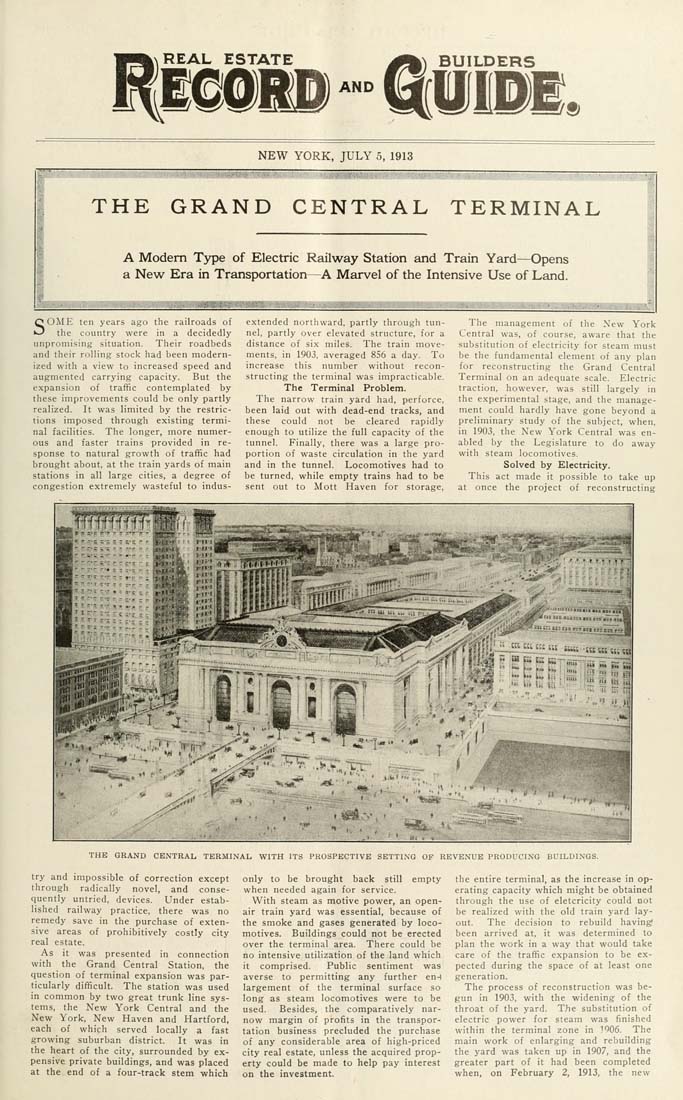Columbia University Libraries Digital Collections: The Real Estate Record
Use your browser's Print function to print these pages.
Real estate record and builders' guide: [v. 92, no. 2364]: July 5, 1913

Text version:
Please note: this text may be incomplete. For more information about this OCR, view About OCR text.
REAL ESTATE AND NEW YORK, JULY 5, 1913 ■llillllillliilliiiiiill THE GRAND CENTRAL TERMINAL I I A Modem T5^e of Electric Railway Station and Train Yard—Opens I a New Era in Transportation—A Marvel of the Intensive Use of Land. s ■iiiiiiilliiiailllillllitilMI^^^^ illillltllilllllilillllBiM^^^^ SOME ten years ago the railroads of the country were in a decidedly unpromising situation. Their roadbeds and their rolling stock had been modern¬ ized with a view to increased speed and augmented carrying capacity. But the expansion of traffic contemplated by these improvements could be only partly realized. It was limited by the restric¬ tions imposed through existing termi¬ nal facilities. The longer, more numer¬ ous and faster trains provided in re¬ sponse to natural growth of traffic had brought about, at the train yards of main stations in all large cities, a degree of congestion extremely wasteful to indus- extended northward, partly through tun¬ nel, partly over elevated structure, for a distance of si.x miles. The train move¬ ments, in 1903, averaged 856 a day. To increase this number without recon¬ structing the terminal was impracticable. The Terminal Problem. The narrow train yard had, perforce, been laid out with dead-end tracks, and these could not be cleared rapidly enough to utilize the full capacity of the tunnel. Finally, there was a large pro¬ portion of waste circulation in the yard and in the tunnel. Locomotives had to be turned, while empty trains had to be sent out to Mott Haven for storage, The management of the New York Central was, of course, aware that the substitution of electricity for steam must be the fundamental element of any plan for reconstructing the Grand Central Terminal on an adequate scale. Electric traction, however, was still largely in the experimental stage, and the manage¬ ment could hardly have gone beyond a preliminary study of the subject, when, in 1903, the New York Central was en¬ abled by the Legislature to do away with steam locomotives. Solved by Electricity. This act made it possible to take up at once the project of reconstructing S0^ '^■ ^ " ^ /;,'<-|.' THE GRAND CE.N'TRAL TERMINAL WITH ITS PROSPECTIVE SETTING OF REVE.NUE PRODUCl.NG BUILDINGS. try and impossible of correction except through radically novel, and conse¬ quently untried, devices. Under estab¬ lished railway practice, there was no remedy save in the purchase of exten¬ sive areas of prohibitively costly city real estate. As it was presented in connection with the Grand Central Station, the question of terminal expansion was par¬ ticularly difficult. The station was used in common by two great trunk line sys¬ tems, the New York Central and the New York, New Haven and Hartford, each of which served locally a fast growing suburban district. It was in the heart of the city, surrounded by ex¬ pensive private buildings, and was placed at the end of a four-track stem which only to be brought back still empty when needed again for service. With steam as motive power, an open- air train yard was essential, because of the smoke and gases generated by loco¬ motives. Buildings could not be erected over the terminal area. There could be no intensive utilization of the land which it comprised. Public sentiment was averse to permitting any further en-) largement of the terminal surface so long as steam locomotives were to be used. Besides, the comparatively nar- now margin of profits in the transpor¬ tation business precluded the purchase of any considerable area of high-priced city real estate, unless the acquired prop¬ erty could be made to help pay interest on the investment. the entire terminal, as the increase in op¬ erating capacity which might be obtained through the use of eletcricity could not be realized with the old train yard lay¬ out. The decision to rebuild having! been arrived at, it was determined to plan the work in a way that would take care of the traffic expansion to be ex¬ pected during the space of at least one generation. The process of reconstruction was be¬ gun in 1903, with the widening of the throat of the yard. The substitution of electric power for steam was finished within the terminal zone in 1906. The main work of enlarging and rebuilding the yard was taken up in 1907, and the greater part of it had been completed when, on February 2, 1913, the new